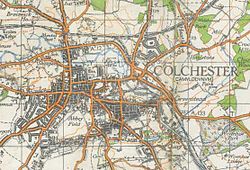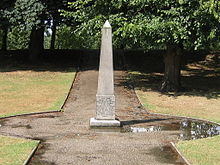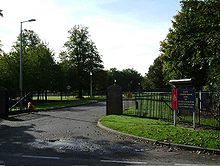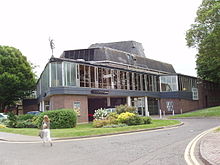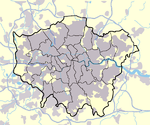- Colchester
-
For other places with the same name, see Colchester (disambiguation).
Coordinates: 51°53′30″N 0°54′11″E / 51.8917°N 0.903°E
Colchester 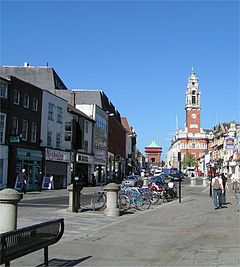
Colchester Town Centre
 Colchester shown within Essex
Colchester shown within EssexPopulation 104,390 (2001 Census) OS grid reference TL997254 District Colchester Shire county Essex Region East Country England Sovereign state United Kingdom Post town COLCHESTER Postcode district CO1 - CO7 Dialling code 01206 Police Essex Fire Essex Ambulance East of England EU Parliament East of England UK Parliament Colchester List of places: UK • England • Essex Colchester (pronounced /ˈkoʊlʧɛstər/ (
 listen)[1]) is an historic town and the largest settlement within the borough of Colchester in Essex, England.
listen)[1]) is an historic town and the largest settlement within the borough of Colchester in Essex, England.At the time of the census in 2001, it had a population of 104,390.[2] However, the population is rapidly increasing, and has been named as one of Britain's fastest growing towns.[3][4][5] As the oldest recorded Roman town in Britain, Colchester claims to be the oldest town in Britain.[6][7] It was for a time the capital of Roman Britain and also claims to have the United Kingdom's oldest recorded market.[8] The town is a member of the Most Ancient European Towns Network.[9]
Colchester is 60 miles (97 km) northeast of London. It is connected to the capital by the A12 road and the Great Eastern Main Line. It is seen as a popular town for commuters,[10] and is less than 30 miles away from Stansted Airport.
Colchester is home to Colchester Castle and Colchester United Football Club. It has a Liberal Democrat Member of Parliament.
Contents
History
Main article: History of ColchesterCeltic origins
Colchester is said to be the oldest recorded town in Britain on the grounds that it was mentioned by Pliny the Elder, who died in AD 79.[11] Before the Roman conquest of Britain it was already a centre of power for Cunobelin - known to Shakespeare as Cymbeline - king of the Catuvellauni (c.5 BC - AD 40), who minted coins there.[12] Its Celtic name, Camulodunon, variously represented as CA, CAM, CAMV, CAMVL and CAMVLODVNO on the coins of Cunobelinus, means 'the fortress of [the war god] Camulos'.[13]
Roman Colchester
Main article: CamulodunumSoon after the Roman conquest of Britain in AD 43, a Roman legionary fortress was established.[14] Later, when the Roman frontier moved outwards and the twentieth legion had moved to the west (c.AD 49), Camulodunum became a colonia named in a second-century inscription as Colonia Victricensis. This contained a large and elaborate Temple to the Divine Claudius.[15]
Camulodunum served as a provincial Roman capital of Britain, but was attacked and destroyed during Boudica's rebellion in AD 61.[16] Sometime after the destruction, London became the capital of the province of Britannia.[17] Colchester's town walls c. 3,000 yd. long were built c.65-80 A.D. when the Roman town was rebuilt after the Boudicca rebellion.[18] In 2004, Colchester Archaeological Trust discovered the remains of a Roman Circus (chariot race track) underneath the Garrison in Colchester, a unique find in Britain.[19]
Sub-Roman and Saxon Colchester
There is evidence of hasty re-organisation of Colchester's defences around 268-82 AD, followed later, during the fourth century, by the blocking of the Balkerne Gate.[20] Dr. John Morris (1913 - June 1977) the English historian who specialised in the study of the institutions of the Roman Empire and the history of Sub-Roman Britain, suggested in his book "The Age of Arthur" (1973) that as the descendants of Romanised Britons looked back to a golden age of peace and prosperity under Rome the name "Camelot" of Arthurian legend was probably a reference to Camulodunum, the capital of Britannia in Roman times.[21]
The archaeologist Sir Mortimer Wheeler was the first to propose that the lack of early Anglo-Saxon finds in a triangle between London, Colchester and St Albans could indicate a 'sub-Roman triangle' where British rule continued after the arrival of the Anglo-Saxons.[22] Since then excavations have revealed some early Saxon occupation, including a fifth-century wooden hut built on the ruins of a Roman house in present-day Lion Walk. Archaeological excavations have shown that public buildings were abandoned, and is very doubtful whether Colchester survived as a settlement with any urban characteristics after the sixth century.[23]
The chronology of its revival is obscure. But the ninth-century Historia Brittonum, attributed to Nennius, mentions the town, which it calls Cair Colun, in a list of the thirty most important cities in Britain.[24] Colchester was in the area assigned to the Danelaw in c.880, and remained in Danish hands until 917 when it was besieged and recaptured by the army of Edward the Elder[25] The tenth-century Saxons called the town Colneceastre, which is directly equivalent to the Cair Colun of 'Nennius'.[26] The tower of Holy Trinity Church is late Saxon work.
Medieval and Tudor period
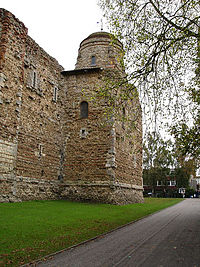 Colchester Castle, constructed over the vaults of the ruined Temple of Claudius.
Colchester Castle, constructed over the vaults of the ruined Temple of Claudius.
Medieval Colchester's main landmark is Colchester Castle, which is an 11th century Norman keep, and built on top of the vaults of the old Roman temple. There are notable medieval ruins in Colchester, including the surviving gateway of the Benedictine abbey of St. John the Baptist (known locally as "St. John's Abbey"), and the ruins of the Augustinian priory of St. Botolph (known locally as "St. Botolph's Priory"). Many of Colchester's parish churches date from this period.
In 1189, Colchester was granted its first royal charter by King Richard I (Richard the Lionheart.) The charter was granted at Dover with the king about to embark on one of his many journeys away from England. The borough celebrated the 800th anniversary of its charter in 1989.[27]
Colchester developed rapidly during the later fourteenth century as a centre of the woollen cloth industry, and became famous in many parts of Europe for its russets (fabrics of a grey-brown colour). This allowed the population to recover exceptionally rapidly from the effects of the Black Death, particularly by immigration into the town.[28]
By the 'New Constitutions' of 1372, a borough council was instituted; the two baillifs who represented the borough to the king were now expected to consult sixteen ordinary councillors and eight auditors (later called aldermen). Even though Colchester's fortunes were more mixed during the fifteenth century, it was still a more important place by the sixteenth century than it had been in the thirteenth. In 1334 it would not have ranked among England's wealthiest fifty towns, to judge from the taxation levied that year. By 1524, however, it ranked twelfth, as measured by its assessment to a lay subsidy.[28]
Between 1550 and 1600, a large number of weavers and clothmakers from Flanders emigrated to Colchester and the surrounding areas.[29] They were famed for the production of Bays and Says cloth. An area in Colchester town centre is still known as the Dutch Quarter and many buildings there date from the Tudor period. During this period Colchester was one of the most prosperous wool towns in England, and was also famed for its oysters.[29] The old Roman wall runs along Northgate Street in the Dutch Quarter.
17th century
In 1648, during the Second English Civil War, a Royalist army led by Lord Goring entered the town. A pursuing Parliamentary army led by Sir Thomas Fairfax and Henry Ireton surrounded the town for eleven and a half weeks, a period known as the Siege of Colchester. It started on the 13 June. The Royalists surrendered in the late summer (on the 27 August Lord Goring signed the surrender document in the Kings Head Inn) and Sir Charles Lucas and Sir George Lisle were executed in the grounds of Colchester Castle.[30] A small obelisk marks the spot where they fell.
Daniel Defoe mentions in A tour through England and Wales that the town lost 5259 people[31] to the plague in 1665, "more in proportion than any of its neighbours, or than the city of London".[31] By the time he wrote this in 1722, however, he estimated its population to be around 40,000 (including "out-villages").
Victorian Colchester
Colchester is noted for its Victorian architecture. Significant landmarks include the Colchester Town Hall and the Jumbo Water Tower.
In 1884, the town was struck by the Colchester earthquake, estimated to have been 4.7 on the Richter Scale causing extensive regional damage.
The Paxman diesels business has been associated with Colchester since 1865 when James Noah Paxman founded a partnership with the brothers Henry and Charles Davey ('Davey, Paxman, and Davey') and opened the Standard Ironworks. In 1925, Paxman produced its first spring injection oil engine and joined the English Electric Diesel Group in 1966 - later becoming part of the GEC Group. Since the 1930s the Paxman company's main business has been the production of diesel engines.
Modern history
In the early twentieth century Colchester lobbied to be the seat for a new Church of England diocese for Essex, to be split off from the existing Diocese of Rochester. The bid was unsuccessful, with county town Chelmsford forming the seat of the new diocese.[32] The University of Essex was established on the outskirts of the town at Wivenhoe Park in 1961.[32] The £22.7M eight-mile A120 Colchester Eastern Bypass opened in June 1982.
Colchester and the surrounding area is currently undergoing significant regeneration,[33] including controversial greenfield residential development in Mile End and Braiswick.[34] The town's football team, Colchester United, moved into a brand new stadium at Cuckoo Farm in 2008.
Colchester, Camulodunum and Colonia Victricensis forms one of 38 sites seeking World Heritage Site status, with a shortlist to be submitted to UNESCO for consideration in 2011.[35] The town is also one of twenty-five across the UK applying for city status to mark the Diamond Jubilee of Elizabeth II in 2012.[citation needed]
Climate
Main article: Climate of the United KingdomColchester, along with other parts of Eastern England, is one of the driest parts of the United Kingdom with average annual precipitation at 453 mm (17.8 inches), some 130 mm less than London which is 56 miles to the south west. Colchester is generally regarded as having an Oceanic climate (Köppen climate classification Cfb) like the rest of the United Kingdom. Its easterly position within the British Isles makes Colchester less prone to Atlantic depressions and weather fronts but more prone to droughts.
This is because like most areas in South-East England, Colchester's weather is influenced more by Continental weather patterns than Atlantic weather systems. This leads to a dry climate compared to the rest of the UK all year round and occasional (relative) extremes of temperatures during the year (occasional late 20°Cs/early30°Cs during the summer) and quite a few nights below freezing during the winter months (daytime high temperatures are seldom below freezing). Any rainfall that does come from Atlantic weather systems is usually light, but a few heavy showers and thunderstorms can take place during the summer. Snow falls on average 13 days a year during winter and very early spring.[citation needed]
The highest temperature recorded in Colchester was 35 °C (95 °F) in August 2003 (during the 2003 European heat wave), and the lowest was −18 °C (−0 °F) in February 2007.
Climate data for Colchester Month Jan Feb Mar Apr May Jun Jul Aug Sep Oct Nov Dec Year Average high °C (°F) 6
(43)6
(43)10
(50)12
(54)16
(61)19
(66)22
(71)22
(71)18
(64)14
(57)9
(48)7
(45){{{year high C}}}
(58)Average low °C (°F) 2
(35)1
(33)3
(37)4
(39)7
(44)10
(50)12
(54)12
(53)10
(50)8
(46)4
(39)3
(37){{{year low C}}}
(44)Precipitation mm (inches) 37
(1.46)30
(1.18)29
(1.14)34
(1.34)32
(1.26)40
(1.57)41
(1.61)38
(1.5)41
(1.61)48
(1.89)44
(1.73)39
(1.54)453
(17.83)Source: MSN Weather Garrison
Main article: Colchester GarrisonColchester has been an important military garrison since the Roman era. The Colchester Garrison is currently home to the 16th Air Assault Brigade. The Army's only military corrective training centre, known colloquially within the forces and locally as "The Glasshouse" after the original military prison in Aldershot,[36] is in Berechurch Hall Road, on the outskirts of Colchester.[37] The centre holds servicemen and women from all three services who are sentenced to serve periods of detention.
From 1998 to 2008, the garrison area of the town underwent massive redevelopment. A lot of the Ministry of Defence land was sold for private housing development and parts of the garrison were moved. Many parts of the garrison now stand empty awaiting the second phase of the development.
Since 2006, Colchester has been one of 12 places in the UK where Royal Salutes are fired to mark Royal anniversaries and visits by foreign heads of state. From 2009, these salutes have taken place in Castle Park.[38]
Governance
Main articles: Colchester Politics, Mayor of Colchester, and Colchester (UK Parliament constituency)The Member of Parliament for Colchester is Bob Russell (LibDem). The Mayor of Colchester is Councillor Henry Spyvee (LibDem).
Colchester Borough Council is the local authority. Control of the borough council has passed between the Conservatives and Liberal Democrats in recent years. The political composition of the council is (2010 election results)[39]
- Liberal Democrats – 26 seats
- Conservative – 24 seats
- Labour – 7 seats
- Others (Highwoods Independent) – 3 seats
The town is also represented on Essex County Council. Individual villages within the borough boundaries are also represented by parish councils.
Demographics
Culture
Museums
Colchester houses several museums. The Castle Museum, found within Colchester Castle, features an extensive exhibit on Roman Colchester. Nearby are Hollytrees Museum, a social history museum with children's exhibits in the former home of Charles Gray, and the town's Natural History Museum, located in the former All Saints' Church. Tymperley's Clock Museum, located in the town centre in a 15th century timber-framed house, once home to William Gilbert, now houses the Bernard Mason clock collection.
Arts
Opened in 1972, the Mercury Theatre is one the region's leading repertory theatres.[citation needed] Next door is Colchester Arts Centre,[40] a multi-function arts venue located in the former St Mary-at-the-Walls church, and home of the Colchester Beer Festival. Headgate Theatre is also in Colchester.
firstsite is a contemporary art organisation, currently housed in the Minories, near the Castle. The Visual Arts Facility, designed by Rafael Viñoly, opened in September 2011, after delays caused by a shortfall in funding at a total cost of approximately £25.5 million, £9 million more than the original estimate.[41]
Other than the Arts Centre, live music venues in Colchester include The Twist, Charter Hall, The Fat Cat (pub), and several others.
In 2009, an art collective called 'Slack Space' took up some of the closed-down shops in the town and converted them into art galleries with the hope of promoting art and design in the town. Art is rather prominent in Colchester due to the Colchester School of Art and Design which is based in Colchester Institute near the centre of the town.
Sports
The town's link with football had begun with the amateur club Colchester Town, formed in 1867 and dissolved in 1937. They were succeeded by professional club Colchester United, who compete in the Football League One and play home games at Colchester Community Stadium. Founded in 1937, the club entered the Football League in 1950. Colchester United Ladies play in the FA Women's Premier League Southern Division. Other sports teams based in the town include Colchester Rugby Football Club, Colchester Gladiators American Football Club, Colchester Weight Lifting Club and Colchester & East Essex Cricket Club. Essex County Cricket Club play some of their home games at Castle Park Cricket Ground, home of Colchester & East Essex.
Sports facilities in Colchester include the sports centre, Colchester Leisure World, Colchester Garrison Athletics Stadium (a co-operative facility used by both the army and civilian population), and a skatepark.
Other
Colchester Zoo is a large zoo based on the outskirts of the town.
Twin towns
Colchester competes in the Twin Town Games against Wetzlar, Avignon, Orléans, Tarragona, and Siena.
Colchester's twin towns are:
Education
Primary and secondary
As is the case for the rest of Essex, Colchester's state schooling operates a two-tier system. Two of the town's secondary schools are selective, Colchester Royal Grammar School and Colchester County High School, the remainder being comprehensives. Comprehensive secondary schools include Alderman Blaxill School, Gilberd School, Colchester Academy, Philip Morant School and College, St Helena Media Arts College, St Benedict's Catholic CollegeThe Stanway School and the Thomas Lord Audley School and Language College.
Private schools
Private schools in Colchester include Colchester High School, Holmwood House School, Oxford House School and St. Mary's School.
Tertiary
The University of Essex is located to the east of Colchester in Wivenhoe Park, in the civil parish of Wivenhoe. Other tertiary institutions include Colchester Sixth Form College and Colchester Institute.
Transport
See also List of bus routes in Colchester
Colchester has a bus system (run by First Essex, Network Colchester, Hedingham Omnibuses, Constable Coaches (Beeston's) Carters Coach Services, Cedric Coaches, New Horizon Travel, H.C. Chambers & Son and Regal Busways which mainly centres around Colchester Temporary Bus Station in the town centre or the one-way system. The temporary bus station is due to close at the end of 2012. As of October 2010, there are currently no plans to replace the bus station. Instead, the town will have several bus 'superstops'.[citation needed]
Colchester is also located on the Great Eastern Main Line-run by National Express east Anglia-with intercity services serving Chelmsford, Ipswich, Norwich, Stratford and London. Other destinations include Peterborough, Cambridge and other more local destinations. These are all from the town's main railway station. Trains also go to Clacton on Sea, Frinton on Sea, Wivenhoe and Walton-on-the-Naze all week from the main station and Monday to Saturday from Colchester Town railway station, located on the Sunshine Coast Line.
Current developments
Cuckoo Farm junction
Main article: A12 road (England)A new junction ('Cuckoo's Farm junction' - Junction 28), connecting the A12 to the town's Northern Approach road was completed in late 2010 at a cost of £25 million[42] close to the new Weston Homes Football Stadium. In July 2008 the then Under Secretary of State for Transport, Tom Harris, stated that work on the development was due to start in 2009 or 2010.[43] Development of the A133, a large congested road that runs through Colchester, is also being reviewed.[44][45]
Myland development
As part of Colchester Borough Council's Core Strategy 2008, there are plans to build thousands of new houses in Myland in the north of Colchester. There is considerable local opposition to this proposal,[34] which is also opposed by the Borough Councillors for Mile End, the Ward councillor for Essex County Council, Myland Parish Council and Bob Russell MP. The project is under review by Colchester Borough Council, and there is some hope that the Core Strategy itself can be reviewed in 2012.
References in literature
The Roman historian Tacitus mentions Colchester (Camulodunum) in The Annals of Imperial Rome. In Book XIV he describes how '...the Roman ex-soldiers...had recently established a settlement at Camulodunum', later burned down in the Iceni rebellion.[46] It is the only town in Britain to have been explicitly mentioned in George Orwell's novel Nineteen Eighty-Four as being the target of a nuclear attack. The (fictional) Atomic Wars took place during the 1950s. Colchester, England is the only town that was specifically mentioned as being bombed, but the book does say that many cities were destroyed in North America, Europe, and Russia.
In popular culture
Colchester is reputed to be the home of three of the best known English nursery rhymes: 'Old King Cole', 'Humpty Dumpty' and 'Twinkle, Twinkle Little Star'. The legitimacy of the claims for the first two of these is disputed.[29]
Local legend places Colchester as the seat of King Cole (or Coel) of the rhyme Old King Cole, a legendary ancient king of Britain. The name Colchester is from Latin: the place-name suffixes chester, cester, and caster derive from the Latin word castrum (fortified place). In folk etymology the name Colchester was thought of as meaning Cole's Castle, though it actually means the Roman fort 'Colonia'. In the legend Helena, the daughter of Cole, married the Roman senator Constantius Chlorus, who had been sent by Rome as an ambassador and was named as Cole's successor. Helena's son became Emperor Constantine I. Helena was canonised as Saint Helena of Constantinople and is credited with finding the true cross and the remains of the Magi. She is now the patron saint of Colchester. This is recognised in the emblem of Colchester: a cross and three crowns. The Mayor's medallion contains a Byzantine style icon of Saint Helena. A local secondary school – St Helena's – is named after her, and her statue is atop the town hall, although local legend is that it was originally a statue of Blessed Virgin Mary which was later fitted with a cross.
Colchester is also the most widely credited source of the rhyme Humpty Dumpty. During the siege of Colchester in the Civil War, a Royalist sniper known as One-Eyed Thompson sat in the belfry of the church of St Mary-at-the-Walls (Humpty Dumpty sat on the wall) and was given the nickname Humpty Dumpty, most likely because of his size, Humpty Dumpty being a common insult for the overweight. Thompson was shot down (Humpty Dumpty had a great fall) and, shortly after, the town was lost to the Parliamentarians (all the king's horses and all the king's men / couldn't put Humpty together again.) Another version says that Humpty Dumpty was a cannon on the top of the church. The church of St Mary-at-the-Walls still retains its Norman tower until the top few feet, which are a Georgian repair.
The third rhyme to come from Colchester is Twinkle Twinkle Little Star, which was written by Jane Taylor in the town's Dutch Quarter, and published in 1806 with the title "The Star".
Colchester has also been suggested as one of the potential sites of Camelot, on account of having been the capital of Roman Britain and its ancient name of Camulodunum.
The first part of Daniel Defoe's Moll Flanders was set in Colchester.[29]
In George Orwell's Nineteen Eighty-Four, the main character, Winston Smith, thinks back to his childhood and his first memories of war, recalling: "Perhaps it was the time when the atomic bomb had fallen on Colchester." (Part 1, Chapter 3). Colchester was also a named line of lathe machinery.[47]
The Doctor Who episodes The Lodger and Closing Time are set in Colchester, although they were filmed in Cardiff.[48]
Notable Colcestrians
People of note that were born or have lived in Colchester include:
- Sir George Biddell Airy (1801–1892) - Astronomer Royal, attended Colchester Royal Grammar School 1814-1819
- Paul Allender (1970–) - musician, lead guitarist of Cradle of Filth
- Cuthbert Alport, Baron Alport - Cabinet Minister, High Commissioner to the Federation of Rhodesia and Nyasaland, High Steward of Colchester
- Ken Aston (1915–2001) - Football referee, responsible for many important developments in football refereeing
- Thomas Audley, 1st Baron Audley of Walden 1488-1544, Lord Chancellor of England 1533-44.
- John Ball (priest) (d. 1381) - leader of the Peasants' Revolt of 1381
- Ali Carter (1979- ) - professional snooker player
- Piers Courage (1942–1970) - Formula One driver
- Graham Coxon (1969- ) - musician and Blur lead guitarist
- Cunobelin - King of the Britons
- Darren Day (1968- ) - actor and television presenter
- Bill Dines (1916–1992) - cricketer
- Neil Faith (1981- ) - professional wrestler
- Neil Foster (1962- ) - cricketer
- William Gilbert (1544–1603) - scientist, pioneer in the field of magnetism and court physician to Elizabeth I and James I
- Sir William Gull, 1st Baronet - Physician-in-Ordinary to Queen Victoria; Governor of Guy's Hospital; researched and named Anorexia nervosa
- Klaus Kinski (1926–1991) - actor, director, former German POW in Colchester during the World War II
- Alfred Lungley (1905–1989) - awarded the George Cross after the Quetta earthquake of 1935
- Bernard Mason - businessman, philanthropist, clock collector
- Philip Morant (1700–1770)- parish priest of St Mary-at-the-Walls, author of The History & Antiquities of the County of Essex
- Graham Napier (1980- ) - cricketer
- Martin Newell (1953- ) - musician, poet, author
- Sheila Nicholls (1970- ) - musician
- Sir Roger Penrose (1931– ), mathematical physicist and philosopher
- Dave Rowntree (1964- ) - musician, drummer for Blur
- Darren Styles (1975- ) - DJ, record producer, singer
- Jane Taylor (1783–1824) - poet and author of the lyrics to Twinkle Twinkle Little Star
- Margaret Thatcher (1925- ) - former Prime Minister, lived in Colchester when working at nearby Manningtree as a research chemist during 1950s.[49]
- Archibald Wavell (1883–1950) British Field-Marshal during World War II, Viceroy of India.
- Mary Whitehouse (1910–2001) - morality campaigner, died in Colchester.
- Sir Laming Worthington-Evans (1868–1931) - Secretary of State for War, Postmaster General
See also
- Statistics of Colchester
- Geography of the United Kingdom#Geology
- List of natural disasters in the United Kingdom and preceding states
- Military history of the United Kingdom during World War II
- Colchester churches
- Church of St Leonard at the Hythe, Colchester
Footnotes
- ^ "Oxford English Dictionary Gateway". Dictionary.oed.com. http://dictionary.oed.com/cgi/entry/50043677?single=1&query_type=word&queryword=Colchester&first=1&max_to_show=10. Retrieved 2010-12-22.
- ^ Key Statistics for urban areas in the South East[dead link]. 2001 Census, National Statistics. Retrieved on February 11, 2007.
- ^ "Concerns over 'fast-growing' town". BBC News. 2010-04-16. http://news.bbc.co.uk/1/hi/uk_politics/election_2010/england/8626127.stm.
- ^ "Population to soar in Colchester above 200,000 (From Gazette)". Gazette-news.co.uk. 2010-05-31. http://www.gazette-news.co.uk/news/local/8193496.Population_to_soar_in_Colchester_above_200_000/. Retrieved 2010-12-22.
- ^ "Colchester: Town the size of Portsmouth in eight years (From Essex County Standard)". Essexcountystandard.co.uk. 2010-06-04. http://www.essexcountystandard.co.uk/news/8199730.Colchester__Town_the_size_of_Portsmouth_in_eight_years/. Retrieved 2010-12-22.
- ^ Colchester Tourist Board (2011 [last update]). "Culture and Heritage". visitcolchester.com. http://www.visitcolchester.com/Culture-and-heritage.aspx. Retrieved 19 May 2011.
- ^ Colchester Tourist Board (2011 [last update]). "Colchester - Britain's Oldest Recorded Town". visitcolchester.com. http://www.visitcolchester.com/Britains-Oldest-Town.aspx. Retrieved 19 May 2011.
- ^ "Markets and fairs". British History Online. http://www.british-history.ac.uk/report.aspx?compid=22000. Retrieved 2010-01-17.
- ^ MAETN (1999 [last update]). "diktyo". classic-web.archive.org. http://classic-web.archive.org/web/20051022022345/http://www.argos.gr/diktyoe.htm. Retrieved 19 May 2011.
- ^ Prophet, Sheila (2006-10-12). "King Commute: the best new property deals within an hour of central London". The Daily Telegraph. http://www.telegraph.co.uk/property/3353621/King-Commute-the-best-new-property-deals-within-an-hour-of-central-London.html.
- ^ Pliny, Naturalis Historia, II, 187
- ^ P. Salway, Roman Britain (Oxford University Press: Oxford, 1981), pp. 55-6
- ^ V. Watts, The Cambridge Dictionary of English Place-Names (Cambridge University Press: Cambridge, 2004), p. 113; T. W. Potter, 'The Transformation of Britain', in P. Salway, ed., The Roman Era (Oxford University Press: Oxford, 2002), p. 21
- ^ J. Nelson, ed., The Victoria History of the County of Essex, IX (Oxford University Press: Oxford, 1994), pp. 7-10
- ^ Nelson, ed. V.C.H. Essex, IX, p. 10
- ^ Salway, Roman Britain, pp. 89-90, 117-18
- ^ Salway, Roman Britain, p. 530
- ^ "Walls and Gates British History". British-history.ac.uk. http://www.british-history.ac.uk/report.aspx?compid=21995. Retrieved 2010-01-17.
- ^ D. Mattingly, An Imperial Possession; Britain in the Roman Empire (Penguin Books: London, 2007), pp. 269-70
- ^ J. Cooper, ed., The Victoria History of the County of Essex, IX: The Borough of Colchester (Oxford University Press: Oxford, 1995), pp. 16-17, 248
- ^ J. Morris, The Age of Arthur: A History of the British Isles from 350 to 650, 3 vols (Phillimore: Chichester, 1977), I, p. 138
- ^ R. E. M. Wheeler, London and the Saxons (London, 1935)
- ^ J. N. L. Myres, The English Settlements (Oxford University Press: Oxford, 1986), p. 214
- ^ Nennius, ed. J. Morris (Phillimore: London and Chichester, 1980); Watts, Cambridge Dictionary of English Place-Names, p. 149
- ^ D, Hill, An Atlas of Anglo-Saxon History (Blackwell: Oxford, 1981), pp. 47, 56-8; The Anglo-Saxon Chronicle, trans. G. N. Garmondsway, 2nd edition (Dent: London, 1954), p. 103; F, Stenton, Anglo-Saxon England, 2nd edition, (Clarendon Press: Oxford, 1947), pp. 324-5
- ^ Watts, Cambridge Dictionary of English Place-Names, p. 149
- ^ "Oyster Fayre - 1989 News Reports". Oysterfayre.flyer.co.uk. 27 December 2002. http://www.oysterfayre.flyer.co.uk/1989newsreports.html. Retrieved 2010-01-17.
- ^ a b R.H. Britnell, Growth and Decline in Colchester, 1300-1525 (Cambridge, 1986, reprinted 2009)
- ^ a b c d Janet Cooper, C R Elrington (Editors), A P Baggs, Beryl Board, Philip Crummy, Claude Dove, Shirley Durgan, N R Goose, R B Pugh, Pamela Studd, C C Thornton (1994). "The Borough of Colchester". A History of the County of Essex: Volume 9: The Borough of Colchester. Institute of Historical Research. http://www.british-history.ac.uk/report.aspx?compid=21968&strquery=colchester. Retrieved 28 July 2011.
- ^ The English Civil War: a military history of the three civil wars, 1642-1651, Young, Peter and Holmes, Richard (1974) p.290. Available here [1]
- ^ a b Daniel Defoe, A tour through England and Wales, J.M. Dent and Sons Ltd, London (1959) Available online here
- ^ a b Janet Cooper, C R Elrington (Editors), A P Baggs, Beryl Board, Philip Crummy, Claude Dove, Shirley Durgan, N R Goose, R B Pugh, Pamela Studd, C C Thornton (1994). "Modern Colchester: Introduction". A History of the County of Essex: Volume 9: The Borough of Colchester. Institute of Historical Research. http://www.british-history.ac.uk/report.aspx?compid=21986&strquery=colchester. Retrieved 28 July 2011.
- ^ "Homepage — Colchester Borough Council". Colchester-regen.co.uk. http://www.colchester-regen.co.uk. Retrieved 2010-01-17.
- ^ a b "Home". Love Myland. http://www.lovemyland.org.uk. Retrieved 2010-12-22.
- ^ "World Heritage applications". Department for Culture, Media and Sport. 7 July 2010. http://www.culture.gov.uk/news/news_stories/7221.aspx. Retrieved 9 August 2010.
- ^ "The Glasshouse — The Aldershot Military Detention Barracks". Hampshire County Council. http://www3.hants.gov.uk/museum/aldershot-museum/local-history-aldershot/glasshouse-aldershot.htm. Retrieved 2008-11-07.
- ^ "Military Corrective Training Centre (MCTC)". www.army.mod.uk. http://www.army.mod.uk/provost/staff/2157.aspx. Retrieved 2008-11-07.[dead link]
- ^ "Honour of Royal Salute switches to Colchester town centre — Colc". Colchester.gov.uk. http://www.colchester.gov.uk/news_det.asp?art_id=8141&sec_id=27. Retrieved 2010-01-17.[dead link]
- ^ "Declaration of Result of Poll for Borough Election held on 6 May 2010". Colchester.gov.uk. http://www.colchester.gov.uk/Info_page_two_pic_2_det.asp?art_id=11154&sec_id=3665. Retrieved 2010-12-22.[dead link]
- ^ "Current Events". Colchester Arts Centre. http://www.colchesterartscentre.com/. Retrieved 2010-01-17.
- ^ "Colchester: £2 m more to finish off new art gallery (From Gazette)". Gazette-news.co.uk. 2008-11-18. http://www.gazette-news.co.uk/news/3856238.Colchester____2m_more_to_finish_off_new_art_gallery/. Retrieved 2010-01-17.
- ^ "Case File O/COL/01/1622". Colchester Borough Council. http://www.planning.colchester.gov.uk/WAM/findCaseFile.do?appNumber=O%2FCOL%2F01%2F1622. Retrieved 2008-11-25.
- ^ "House of Commons Tuesday 8 July 2008". UK Parliament. http://www.parliament.the-stationery-office.com/pa/cm200708/cmhansrd/cm080708/debtext/80708-0001.htm. Retrieved 2008-11-25.
- ^ "A133 Consultation Result". Essex County Council. http://www.essexcc.gov.uk/vip8/ecc/ECCWebsite/content/binaries/documents/A133_Consultation_-_results_PDF.pdf?channelOid=null. Retrieved 2009-10-14.[dead link]
- ^ "Colchester Central Corridor". Essex County Council. http://www.essexcc.gov.uk/vip8/ecc/ECCWebsite/dis/guc.jsp?channelOid=16819&guideOid=32956&guideContentOid=94291. Retrieved 2009-10-14.[dead link]
- ^ Tacitus, Annales, XIV, 31
- ^ "As detailed here". Lathes.co.uk. http://www.lathes.co.uk/colchester/index.html. Retrieved 2010-12-22.
- ^ var authorId = "67932151" by Matt Wales IGN UK (2010-06-14). "IGN review". Uk.tv.ign.com. http://uk.tv.ign.com/articles/109/1096927p1.html. Retrieved 2010-12-22.
- ^ "MT at 80 | Margaret Thatcher Foundation". Margaretthatcher.org. http://www.margaretthatcher.org/essential/MT80.asp. Retrieved 2010-01-17.
External links
- Colchester Borough Council
- Community website opposing large-scale development in North Colchester
- Colchester - Britain's first Roman city
- Visitors' guide to Colchester
- Colchester24 - A Day in the Life of Colchester
- Colchester Digital Images - Photographic Galleries of The Colchester Area
- Roman Colchester - A Virtual Experience
- The official tourism website for Colchester, Britain's oldest recorded town
The towns and villages of the Colchester borough of Essex, England Abberton • Aldham • Barrow Hill • Birch • Boxted • Colchester • Fingringhoe • Fordstreet • Marks Tey • Myland • Old Heath • Stanway • Tiptree • West Mersea • Wivenhoe • West Bergholt •
Islands: Mersea Island
Ceremonial county of Essex Unitary authorities Boroughs or districts Major settlements - Basildon
- Billericay
- Braintree
- Brentwood
- Brightlingsea
- Buckhurst Hill
- Burnham-on-Crouch
- Canvey Island
- Chelmsford
- Chigwell
- Chipping Ongar
- Clacton-on-Sea
- Coggeshall
- Colchester
- Corringham
- Dovercourt
- Eastwood
- Epping
- Frinton-on-Sea
- Grays
- Great Dunmow
- Hadleigh
- Halstead
- Harlow
- Harwich
- Holland-on-Sea
- Ingatestone
- Laindon
- Langdon Hills
- Leigh-on-Sea
- Loughton
- Maldon
- Manningtree
- Pitsea
- Rayleigh
- Rochford
- Saffron Walden
- Shoeburyness
- South Benfleet
- Southend-on-Sea
- South Woodham Ferrers
- Southminster
- Stanford-le-Hope
- Thaxted
- Tilbury
- Waltham Abbey
- Walton-on-the-Naze
- West Mersea
- West Thurrock
- Wickford
- Witham
- Wivenhoe
See also: List of civil parishes in Essex
Rivers Topics Categories:- Colchester
- Ports and harbours of Essex
- Roman colonies
- Market towns in Essex
- Trading posts of the Hanseatic League
- Towns in Essex
Wikimedia Foundation. 2010.


